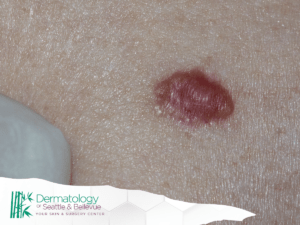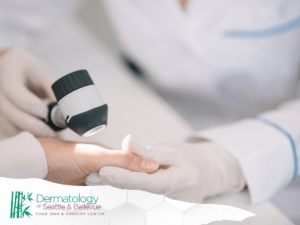Mohs surgery, also called Mohs micrographic surgery, is a highly specialized and precise technique used to treat certain types of skin cancer, particularly those with a high risk of recurrence or located in sensitive areas like the face.
During the process, doctors take out small pieces of cancerous tissue and look at them right away with a microscope. This process continues until no cancer cells are detected, preserving as much healthy tissue as possible. Mohs surgery is a good option for treating skin cancer in sensitive areas. It has high cure rates and causes minimal scarring.
Complete Cancer Cell Removal: Ensuring No Cancer Cells Remain Post-Mohs Surgery
Mohs surgery is renowned for its precision in removing cancerous tissue, layer by layer until no cancer cells remain. This meticulous approach aims to preserve as much healthy skin as possible.
During the procedure, each layer of tissue is examined under a microscope in real time. This process continues until no cancer cells are detected, guaranteeing complete cancer cell removal. Mohs surgery’s unparalleled accuracy makes it a gold standard for treating skin cancers, especially those in critical areas like the face. It provides patients with the reassurance that their cancer is thoroughly eradicated.
Post-Mohs Surgery Care
After undergoing Mohs surgery, proper post-operative care is essential for a smooth recovery and optimal wound healing. Here are some key steps to follow:
- Wound Care: Keep the surgical site clean and dry. Your dermatologist will provide specific instructions on wound care. Typically, you’ll need to change the dressing and clean the area as directed.
- Vaseline Application: Applying Vaseline to the surgical site is often recommended. It helps keep the wound moist and promotes healing. Follow your dermatologist’s advice on how long to use Vaseline.
- Avoid Sun Exposure: Protect the surgical site from direct sunlight. Use sunscreen or wear protective clothing to prevent sun damage during the healing process.
- Medications: Take any prescribed medications as instructed, especially if antibiotics or pain relievers are prescribed.
- Follow-Up Appointments: Attend all scheduled follow-up appointments with your dermatologist. They will monitor your healing progress and address any concerns.
- Activity Restrictions: Your dermatologist may recommend limiting strenuous activities or movements that could strain the surgical area.
- Stay Hydrated and Eat Well: Proper nutrition and hydration support the healing process.
Remember that individual recovery times may vary, so following your dermatologist’s personalized instructions is crucial for the best outcomes.

The Role of Vaseline
Vaseline, a brand name for petroleum jelly, plays a significant role in post-Mohs surgery care. Its benefits include:
- Moisture Retention: Vaseline keeps the wound moist, promoting faster healing and minimizing scarring.
- Protection: It acts as a barrier, shielding the surgical site from external contaminants and reducing infection risks.
- Minimizing Scarring: By preventing the wound from drying out, Vaseline can help minimize scarring and improve cosmetic outcomes.
- Reducing Discomfort: Vaseline can alleviate discomfort by preventing the dressing from sticking to the wound.
Remember to ask the dermatologist about using Vaseline after Mohs surgery for proper care instructions.
How a Thin Layer of Vaseline Preserves Healthy Skin?
Beyond its ubiquitous presence in medicine cabinets, Vaseline is a guardian of healthy skin during recovery.
By creating a thin, protective layer, Vaseline acts as a barrier against external contaminants and premature drying. This shield helps wounds heal faster, reduces scarring, and prevents dressings from sticking to the wound, reducing discomfort.
Vaseline helps protect your skin during Mohs surgery recovery, keeping it healthy and intact.
How Long Should You Use Vaseline?
The duration of Vaseline use after Mohs surgery varies from patient to patient. Generally, it’s recommended to apply Vaseline until the wound has fully healed, which can take several weeks. Your dermatologist will provide specific instructions based on your individual case.
They may advise you to continue using Vaseline until any scabs or crusts have disappeared and the skin has regained its normal texture and color.
Regular follow-up appointments will allow your dermatologist to monitor your healing progress and guide you on when to stop using Vaseline.
When Can You Take a Shower After Mohs Surgery?
Maintaining proper hygiene is important after Mohs surgery, but it’s crucial to follow your dermatologist’s instructions regarding showering. Typically, you should avoid getting the surgical site wet for at least the first 24 hours after the procedure. Your dermatologist will provide specific guidelines based on your case. They may recommend using a plastic covering or waterproof dressing to protect the area during showers.
It’s essential to be gentle and avoid scrubbing or rubbing the surgical site. Always consult with your healthcare provider to ensure you’re following the appropriate post-surgery care routine.
How Often Should I Change My Dressing After Mohs Surgery?
Proper wound care is a critical aspect of the post-Mohs surgery recovery process. One common question patients have is how often they should change their dressing after the procedure. The frequency of dressing changes can vary depending on individual cases and your dermatologist’s instructions.
Generally, dressings should be changed as per your dermatologist’s recommendations, which may vary from daily to every few days. It’s essential to keep the surgical site clean and dry and follow your healthcare provider’s guidance for the best results.






